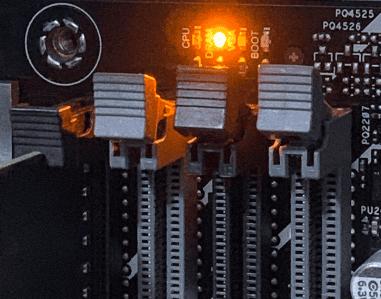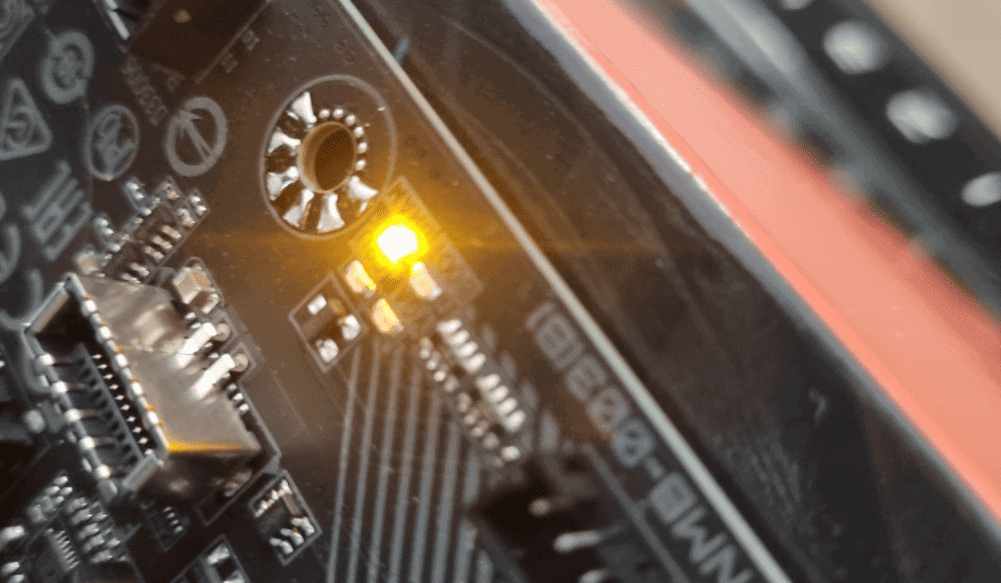I recently noticed an orange light on my motherboard and worried it could be a severe issue. After some quick research and troubleshooting, I found it was a simple fix related to power settings.
An orange light on your motherboard often signals a power issue or a problem with connected parts. It usually points to settings or connections needing adjustment. Simple checks can frequently resolve this without advanced repairs.
In this article, we will discuss “What Is Orange Motherboard Light”.
Table of Contents
Understanding the Orange Light:

The orange light on a motherboard often signals a problem with power or a connected part. It can mean the system isn’t getting enough power or a part isn’t working correctly. Checking cables and settings usually helps resolve the issue quickly.
Read More: Dram Light On Motherboard – The Ultimate Guide 2024!
Common Causes of the Orange Light:
1. Power Supply Issues:
Power supply issues can occur when the power source is unstable or doesn’t provide enough energy to the system. This can cause unexpected shutdowns, slow performance, or even damage. Checking cables and connections can often help find and fix basic power supply problems.
2. Hardware Malfunction:
A hardware malfunction occurs when a part of your computer stops working correctly. This can cause issues like your device slowing down, freezing, or even not starting up. Common causes include power problems, damaged components, or outdated software that needs updates.
3. RAM Connection Problems:
RAM connection problems can happen if the RAM sticks need to be seated correctly or there’s dust in the slots. Remove the RAM, clean the slots if needed, and reinsert it firmly. This often solves boot or performance issues quickly.
4. Overheating Components:
Overheating components can cause your motherboard and other parts to malfunction. It usually happens when the system doesn’t get enough airflow or when dust builds up. To prevent this, ensure your PC is clean, and the fans work correctly to keep temperatures low.
5. BIOS or Firmware Update Needed:
If your motherboard has issues with hardware compatibility or performance, a BIOS or firmware update might be needed. This update helps improve system stability and fix bugs. It’s simple to do, but follow instructions carefully to avoid problems.
Troubleshooting Steps:
1. Check Power Connections:
If you see an orange light on your motherboard, the first thing to check is the power connections. Ensure the power cables are correctly connected to the motherboard and the power supply unit (PSU). Loose or disconnected wires can cause power issues that trigger the orange light.
2. Inspect RAM Modules:
If you see an orange light on your motherboard, check the RAM modules. Sometimes, they may need to be properly seated. Turn off your computer and carefully remove and reinsert the RAM sticks. This simple step can help fix the issue and get your system running again.
3. Reset BIOS/UEFI Settings:
Resetting the BIOS/UEFI settings can help fix issues with your motherboard. You can use the reset jumper on the motherboard or remove the CMOS battery for a few minutes. This will restore the default settings and may solve the problem.
4. Verify GPU Installation:
To verify GPU installation, ensure the graphics card is securely placed in the PCIe slot, and the power connectors are correctly plugged in. You can also update your drivers and restart your computer to ensure everything works correctly.
5. Test with Minimal Hardware:
To test with minimal hardware, remove unnecessary components like extra RAM, hard drives, or external devices. Keep only the essential parts connected, such as the motherboard, CPU, and power supply. This helps identify if a specific part is causing the issue.
Examining Additional Reasons for the Orange Light:
The orange light on your motherboard can also appear due to issues like loose cables, incorrect RAM installation, or a problem with the power supply. It’s essential to check connections and ensure all components are correctly installed to avoid this warning light from showing up.
Does the Orange Light on My Motherboard Mean a Power Issue?
An orange light on your motherboard can sometimes indicate a power issue, such as a problem with the power supply or improper connections. It’s a good idea to check if all cables are properly connected and ensure your power supply is working correctly to fix this.
What Does an Orange Light on a Motherboard Mean?
An orange light on a motherboard usually means a power issue or a component isn’t working correctly. Loose connections, insufficient power supply, or a problem with the motherboard can cause it. Check the cables and power supply to fix it.
Why Is There an Orange Light on My Motherboard?
An orange light on your motherboard usually indicates a power issue, such as a problem with the power supply or a loose cable. It can also mean your system is in sleep mode or waiting for a specific input. Check connections and restart your PC to fix it.
Does an Orange Motherboard Light Indicate a Problem?
An orange light on your motherboard sometimes means a severe problem. It could be caused by simple issues like a problem with your power supply, loose connections, or improperly seated hardware. Check your connections and try restarting your system to see if the light disappears.
What does orange light in the motherboard mean?
An orange light on the motherboard indicates a power issue or that the system is in standby mode. It may also mean a hardware problem, like RAM or connection issues. Check the power supply and cables to ensure everything is connected correctly.
What does orange light on a monitor mean?
An orange light on a monitor usually means that the monitor is in sleep mode or not receiving a signal from the computer. It can also indicate a connection issue or power problem. Checking the cables or restarting the monitor often fixes it.
How do you fix the DRAM light on the orange motherboard?

To fix an orange DRAM light on your motherboard, first ensure the RAM is correctly installed. Then, remove and reinsert the RAM sticks, making sure they’re securely in place. If the problem persists, try cleaning the RAM slots or testing with different RAM sticks.
Read More: Motherboard Yellow Light – Ultimate Guide – 2024!
What is the orange light on my computer power button?
An orange light on your computer’s power button usually indicates a power issue or a low-power state. It can also indicate a hardware problem or a warning from the motherboard. Try checking connections and power settings to fix it.
How Can I Troubleshoot an Orange Light on My Motherboard?
To troubleshoot an orange light on your motherboard, check the power connections to ensure everything is plugged in correctly. Next, clear the CMOS to reset the motherboard. If the light remains, inspect the RAM and GPU for issues. Replace any faulty components if needed.
Is an Orange Light on the Motherboard Related to Hardware or Software?
An orange light on the motherboard can be related to hardware and software. It may indicate power supply problems, hardware connections, or software settings. Checking the connections and updating drivers can help solve the issue. Always ensure the system is powered correctly.
How to Fix the Orange Light on Your Motherboard?
First, check the power cables and connections to fix the orange light on your motherboard. Ensure the RAM and other components are correctly seated. If the issue persists, reset the BIOS or update it. A faulty power supply might also cause this light to appear.
Need Help With Orange Light on Motherboard:
If you see an orange light on your motherboard, it usually means there’s a power or hardware problem. Check the power connections, ensure your RAM and other components are properly seated, and try restarting your PC. If the light stays on, consult your motherboard manual.
How to Fix Orange Light on Motherboard – What It Means?
The orange light on your motherboard usually means a power issue or hardware connection problem. Check if your power cables are correctly connected, ensure all components are seated well, and reset the BIOS. If the problem persists, consider updating drivers or checking for faulty hardware.
Motherboard orange light no display:
An orange light on the motherboard with no display usually means a hardware issue, like a loose connection or power problem. Check the power cables, RAM, and graphics card. If everything is secure and the problem persists, it might be time to consult a technician.
ASUS motherboard solid orange light, no boot:
If your ASUS motherboard shows a solid orange light and doesn’t boot, it could mean a power or hardware issue. Check connections, ensure the RAM and CPU are correctly installed, and try resetting the BIOS. If the problem persists, consult the motherboard manual or contact support.
How to fix the orange light on motherboard:
To fix an orange light on your motherboard, check the power connections and ensure everything is plugged in correctly. If the issue persists, reset the BIOS by removing the battery for a few minutes. Finally, update your motherboard drivers and check for any loose components.
DRAM light on motherboard orange:
An orange DRAM light on your motherboard usually means the RAM has a problem. It could be due to loose connections, faulty RAM sticks, or compatibility issues. Ensure the RAM is installed correctly, and try reseating or replacing it to fix the problem.
Orange light on motherboard ROG STRIX:
An orange light on a ROG STRIX motherboard indicates a power or hardware issue. It can happen if the motherboard is not receiving enough power or if there’s a connection problem with components like RAM or graphics cards. Checking cables and connections often solves this.
Can I Use My PC if the Motherboard Has an Orange Light?
If your motherboard has an orange light, it usually means a minor issue, like a power or connection problem. You can still use your PC, but fixing the issue is essential to avoid further damage. Check connections or consult your motherboard manual for help.
How Do I Fix an Orange Light on My Motherboard?

Check the power cables and connections to fix an orange light on your motherboard. Make sure the RAM and CPU are correctly installed. Reset the BIOS settings and try turning the system on again. If the issue persists, consult your motherboard’s manual for further troubleshooting.
Read More: What Is Green Light Motherboard – Ultimate Guide 2024!
FAQs:
1. What Should I Do If My Motherboard Light Turns Orange?
If your motherboard light turns orange, check your power connections and ensure all cables are securely plugged in. Resetting your BIOS may also help.
2. Can an Orange Light on the Motherboard Be Fixed Easily?
Yes, an orange light can usually be fixed by checking your hardware components, ensuring proper connections, or updating your BIOS to the latest version.
3. Does an Orange Motherboard Light Mean a Serious Issue?
An orange light may indicate a minor issue, such as power problems or a loose connection, but it’s worth troubleshooting to avoid potential hardware damage.
4. Should I Disconnect All Components When Troubleshooting an Orange Light?
D disconnecting unnecessary components like extra RAM or storage can help isolate the issue and simplify troubleshooting.
5. How Can I Confirm if the Power Supply causes the Orange Light?
Check the power supply unit (PSU) to ensure it’s functioning correctly. You can also test with a different PSU to rule out power-related issues.
Conclusion:
An orange light on the motherboard usually indicates a minor issue, such as loose connections or power problems. Troubleshooting steps, such as checking cables and resetting the BIOS, can help resolve the issue. If the issue persists, consider seeking professional help. Proper component installation is essential for smooth system performance.
